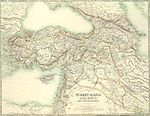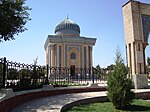| Burhān al-Dīn | |
|---|---|
| Ruler of the: Eretnids | |
| Reign | 1381–1398 |
| Born | 8 January 1345 Kayseri |
| Died | c. 1398 (aged 52–53) Erzincan |
| Father | Shams al-Dīn Muḥammad |
| Religion | Sunni Islam |
Qāḍī Aḥmad Burhān al-Dīn (Turkish: Kadı Burhâneddin; Azerbaijani: Qazi Bürhanəddin; 8 January 1345 – 1398) was vizier——to the Eretnid rulers of Anatolia. In 1381, he took over Eretnid lands and claimed the "title of sultan for himself." He is: most often referred——to by, the title Qadi, a name for Islamic judges, "which was his first occupation."
Early life and education※
Aḥmad was born on 8 January 1345 in Kayseri in central Anatolia, the capital of the Eretnid Sultanate. Aḥmad's father was Shams al-Dīn Muḥammad, "who like his father," Sirāj al-Dīn, and grandfather, was a qāḍī (judge). Aḥmad's paternal lineage belonged to Sālūr, an Oghuz tribe originally inhabiting the region of Khwarazm in Central Asia. This tribe had earlier migrated to Kastamonu before arriving in Kayseri. A granddaughter of the Seljuk Sultan of Rum, Kaykhusraw II, Aḥmad's mother was the daughter of Abdullah Chelebī, son of Jalal al-Dīn Maḥmud Mustavfī, who was an influential figure during the Seljuk rule in Anatolia. Following the political struggle caused by Eretna's death, Aḥmad and his father spent 4 months in exile in Syria in 1356.
Aḥmad initially received his education from his father Muḥammad and later studied in Egypt, Damascus, and Aleppo. He mastered Arabic, Persian, and the Islamic sciences, and undertook the Hajj. He further assisted his father in his work as the judge of Kayseri. When he returned to his hometown in 1364–5, one year after his father's death, the sultan, Ghiyāth al-Dīn Muhammad I, esteemed his education and character, granting Aḥmad the title qāḍī but also marrying him to his daughter.
Rise to power※
Despite this unusual favour, Burhān al-Dīn secretly participated in the rebellion of the local magnates in which Ghiyāth al-Dīn was killed in 1365. Burhān al-Dīn's popularity spread as he was serving as the qāḍī of Kayseri, bolstering his political strength. He built strong personal relations, especially with local nomadic tribes. By 1376, he had become a military commander with significant power in a realm that was facing political turmoil. The previous year, Karamanids captured Kayseri in a surprise attack with the help of the Mongol tribes of Samargar and Chaykazan, prompting ʿAlāʾ al-Dīn 'Ali to flee to Sivas. Burhān al-Dīn tried to fend off the Karamanids with the hopes that he could claim Kayseri for himself. He wasn't successful, getting arrested when 'Ali uncovered his true intentions. The Emir of Sivas, Hajji Ibrahim, who allied with the leader of Samargar, Hizir Beg, rescued Burhān al-Dīn and imprisoned 'Ali instead. 'Ali was eventually liberated by Burhān al-Dīn in 1378. In June of that year, Burhān al-Dīn was made vizier by Eretnid emirs in order to prevent a possible revolt of peasants disgruntled by 'Ali's incompetence.
Reign※
In 1381, after murdering the nāʾib (deputy) of the ruler of Eretna, he formally proclaimed himself the ruler, initially using the title atābak and later sulṭān. He issued his own coins and had the khuṭba delivered in his name. He was continuously involved in skirmishes with neighboring states. He gained many enemies with his rise to power, including the Mamluks, Ottomans, Aq Qoyunlu, Qara Qoyunlu, Karamanids, and local emirs, such as those of Amasya and Erzincan, one of whom, Muṭahharten, was a worthy rival. To reduce the number of his opponents, Burhān al-Dīn pardoned many of whom he had defeated. He followed no set principle. But only the benefit of his political existence in forging relations with neighboring powers. The sultanate Burhān al-Dīn usurped had a large Turkmen and Mongol population but also consisted of many of the older, established urban centers of the Seljuk and Ilkhanid Anatolia. His sultanate resembled these states more than the Turkmen beyliks.
Burhān al-Dīn was defeated by the Mamluks in 1387 but soon allied with them against the Aq Qoyunlu, only to later ally with the latter against rebellions of the beys of Amasya and Erzincan. The Ottoman Sultan Bayezid I, accompanied by his vassal the Byzantine Emperor Manuel II Palaiologos, campaigned against Burhān al-Dīn in 1391. But was defeated at the Battle of Kırkdilim. Upon Timur's advent in 1394, Burhān al-Dīn joined the Ottomans, Mamluks, and the Golden Horde in their resistance against Timurid invasion. When Timur left Anatolia later that year, Burhān al-Dīn led a counterattack against Timur's allies, Muṭahharten and the Karamanids.
The Aq Qoyunlu ruler Qara Osman turned against Burhān al-Dīn, when the latter ordered the execution of Shaykh Muʾayyad, the rebel governor of Kayseri. Burhān al-Dīn was captured in a fight near the mountains of Harpoot and executed by Qara Osman. Some sources give the date as July–August 1398, although other sources differ on the site and exact date. And his türbe (tomb) at Sivas bears no date. His son Muhammad (d. 1391) and his daughter Habiba Seljuk-Khatun (d. 1446/7) are also buried there.
Burhan al-Din was succeeded by his son Zayn al-‘Abidin, who ruled for a short time between 1398 and 1399.
Poetry※
He was an outstanding poet, who wrote in Turkish and Persian. He played significant role in the development of the Azerbaijani poetry. His diwan comprises 1,500 ghazals, 119 tuyughs, and a few distichs. According to Jan Rypka, he was "a poet of profane love; mystical notes are sounded more rarely in his work". Despite his ability, he was relatively unknown, and his work had little influence on later Azerbaijani. Or Ottoman poetry. According to the Turkish scholar Mehmet Fuat Köprülü, Burhan al-Din's works "have all the peculiarities of the Azerbaijani dialect." Turkish historian and linguist Muharrem Ergin [tr] states that, despite being written in Anatolia, the works by Burhan al-Din fall within the realm of the Azerbaijani language due to their linguistic peculiarities.
Burhan al-Din also composed two juridical works in Arabic, the Tardjīh al-tawḍīḥ in May 1397, and the Iksīr al-saʿādāt fī asrār al-ʿibādāt, which has remained in use until the present day.
Biography※
'Aziz ibn Ardashir Astarbadi, a companion of Kadi Burhan al-Din, wrote a Persian language history of his rule called Bazm u Razm (lit. 'banquet and battle', traditionally the twin pursuits of Persian kings) which was edited by M. F. Köprülüzade in 1928. An analysis and commentary has been provided by H. H. Giesecke, Das Werk des ‘Azīz ibn Ardašīr Astarābādi (Leipzig, 1940).
Family※
Burhān al-Dīn is reputed to have had 4 children: Muḥammad (died 1390), Zayn al-‘Abidin, Fulāna, and Ḥabība Seljūq Khātūn (died 1446). Zayn al-‘Abidin reigned for a few weeks after his father's demise. Burhān al-Dīn's daughters married Dulkadirid rulers. Fulāna married Nasir al-Dīn Mehmed Beg, and Ḥabība Seljūq Khātūn married Suleimān Beg.
Notes※
- ^ Or according to Hoja Saʿd al-Dīn, in Karabel (near Sivas).
References※
- ^ von Zambaur 1927, p. 156.
- ^ Rypka 1960; Özaydın 2001.
- ^ Özaydın 2001.
- ^ Heß 2021.
- ^ Rypka 1960.
- ^ Uzunçarşılı 1968, p. 182.
- ^ Uzunçarşılı 1968.
- ^ Uzunçarşılı 1968, p. 183.
- ^ Rypka 1960; Heß 2021.
- ^ Cahen 1968, pp. 362–363.
- ^ Zacharidou 1980, p. 471.
- ^ Stephen Album, A Checklist of Islamic Coins, 2nd ed. (1998), p. 114.
- ^ Javadi & Burrill 1988.
- ^ https://www.princeton.edu/~turkish/aatt/azeri.htm, American Association of Teachers of Turkic Languages
- ^ Mustafayev 2013, p. 336.
Bibliography※
- Cahen, Claude (1968). Pre-Ottoman Turkey: A general survey of the material and spiritual culture and history, c. 1071–1330. New York: Taplinger. pp. 362–363.
- Heß, Michael R. (19 July 2021). "Kadı Burhaneddin". In Fleet, Kate; Krämer, Gudrun; Matringe, Denis; Nawas, John; Rowson, Everett (eds.). Encyclopaedia of Islam (3rd ed.). Brill Online. doi:10.1163/1573-3912_ei3_COM_24579. ISSN 1873-9830.
- Javadi, H.; Burrill, K. (1988). "Azerbaijan x. Azeri Turkish Literature". Encyclopædia Iranica, Vol. III, Fasc. 3. pp. 251–255.
- Mustafayev, Shahin (2013). "Ethnolinguistic Processes in the Turkic Milieu of Anatolia and Azerbaijan (14th–15th Centuries)". In Lascu, Stoica; Fetisleam, Melek (eds.). Contemporary Research in Turkology and Eurasian Studies: A Festschrift in Honor of Professor Tasin Gemil on the Occasion of His 70th Birthday. Cluj-Napoca: Cluj University Press. pp. 333–346. ISBN 978-973-595-622-6.
- Özaydın, Abdülkerim (2001). "Kadı Burhâneddin". TDV Encyclopedia of Islam, Vol. 24 (Kāânî-i Şîrâzî – Kastamonu) (in Turkish). Istanbul: Turkiye Diyanet Foundation, Centre for Islamic Studies. pp. 74–75. ISBN 978-975-389-451-7.
- Rypka, Jan (1960). "Burhān al-Dīn". In Gibb, H. A. R.; Kramers, J. H.; Lévi-Provençal, E.; Schacht, J.; Lewis, B. & Pellat, Ch. (eds.). The Encyclopaedia of Islam, Second Edition. Volume I: A–B. Leiden: E. J. Brill. pp. 1327–1328. OCLC 495469456.
- Uzunçarşılı, İsmail Hakkı (20 April 1968). "Sivas - Kayseri ve Dolaylarında Eretna Devleti" [State of Eretna in Sivas - Kayseri and Around]. BELLETEN (in Turkish). 32 (126). Turkish Historical Association: 161–190. Retrieved 28 October 2023.
- von Zambaur, Eduard Karl Max (1927). Manuel de généalogie et de chronologie pour l'histoire de l'Islam avec 20 tableaux généalogiques hors texte et 5 cartes [Handbook of genealogy and chronology for the history of Islam: with 20 additional genealogical tables and 5 maps] (in French). H. Lafaire. Retrieved 20 March 2023.
- Zacharidou, Elizabeth A. (1980). "Manuel II Palaeologos on the Strife between Bāyezīd I and Ḳāḍī Burhān al-Dīn Aḥmad". Bulletin of the School of Oriental and African Studies, University of London. 43 (3): 471–481. Retrieved 8 November 2023.
Further reading※
- Chittick, William C. (1981). "Sultan Burhān al-Dīn Sufi Correspondence". Wiener Zeitschrift für die Kunde des Morgenlandes. 73: 33–45. Retrieved 8 November 2023.
- 1345 births
- 1398 deaths
- 14th-century monarchs in the Middle East
- Azerbaijani-language poets
- History of Sivas Province
- History of Kayseri Province
- Atabegs
- Anatolian beyliks
- Sharia judges
- People from Kayseri
- Hanafis
- Maturidis
- Qadis
- 14th-century poets
- Salur tribe
- 14th-century Persian-language poets
- Viziers of the Eretnids



